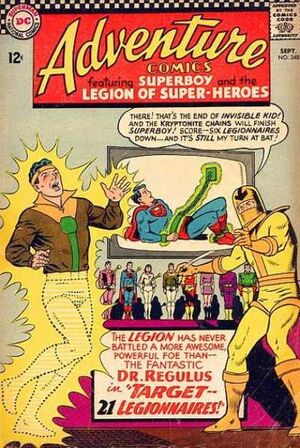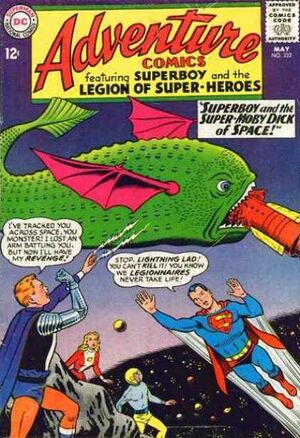Chapter Eight
One of the Myriads had done the unthinkable. She had slipped past Superboy and
Mon-El. While her replicates kept
the two Legion titans busy, she alone accessed the corridor to the main lab. It had
been easier than she thought. Blame it
on male egos – they probably never thought a mere Carggite girl would
outsmart them.
But there was no time to be overconfident. The sheer number of replicates had taken a
serious toll. Myriad found it difficult to focus
on her mission or to even remember why she was there in the first place. But in a few minutes, her mission would all be
over and no one would ever stop her again.
She found the door to the main lab strangely unguarded. Surely the Legionnaires knew where she was
heading by now. Why hadn’t they posted
more Legionnaires outside, or even automated sentries? Perhaps she had already encountered all of the available Legionnaires.
No matter. She placed Invisible Kid's flight ring in front of the scanner. The door whisked open.
The main lab sprawled out before her like a mini-citadel of
its own, with rows and rows of objects she couldn’t begin to recognize. She could get lost for days trying to
find what she wanted.
But there it was, right in front of her. The upright diagnostic bed was unmistakable,
as were the cylindrical apertures extending from its side.
Starfinger’s psonic analyzer.
She went cold. Repressed memories came flooding back. Why in the galaxy did she want to
expose herself to such agony again?
“My deductions were correct,” came a voice from behind her. Myriad spun around and came face to face with
Brainiac 5, the Legion’s super-genius.
He stood with his arms folded, looking not the least surprised. “It is the Hanscom cellular duplicating ray
you are after.”
“H-Hanscom?” Myriad
said, the name dimly familiar.
“Dr. Lars Hanscom. Better known as Starfinger. You know Starfinger very well, don’t you,
Thleka Caredi?”
“Y-You know my name?”
“Once I deduced that our intruder was Carggite, it was simply a matter of scanning the holo-news from your world.” Brainiac 5 stepped forward slightly. "One report,
several months old, told of a young woman being abducted in broad daylight by
a winged creature which teleported out of nowhere. It had to be Warxxi, Starfinger’s winged
servant.”
Myriad blinked as the memory resurfaced. She had been on her way to the Temple of the Three Suns when the creature appeared out of nowhere. Its scaly wings blotted out the sky. People around her ran, but she couldn't move. It's raw power, it's sheer grace and beauty transfixed her. She didn't realize it was coming for her until it was too late.
"Starfinger wanted to know the secret of Carggite replication," Brainiac 5 continued, "so he could create more replicates of himself. "He must have experimented on you, a random citizen of Cargg, before he perfected the process and tried again by recently kidnapping Duo Damsel."
"He tortured me with that device!" Myriad pointed to the psonic analyzer. "It felt like he was splitting me apart atom by atom, and then he just returned me to Cargg, as if nothing ever happened."
"But something did happen afterwards, didn't it?" Brainiac 5's tone was sympathetic, even compassionate. "You split into four, and then five, and then six bodies. Replicating more than twice is not unknown on Cargg, but it is rare. You were regarded as a freak, an abomination . . ."
"They shunned me! I didn't ask for any of this, but it didn't matter."
"And yet you want to expose yourself to the psonic analyzer again."
Myriad realized the Coluan probably already knew of the toll creating so many replicates was taking on her. "If I can correct the imbalance, I can create even more replicates of myself without straining," she admitted.
"And then what will you do?"
“I’ll create an army and return to Cargg! I'll make them pay for shunning me."
“So, that’s what you want, simple revenge?” Brainiac 5 asked, rhetorically. “You are a sick woman, Thleka. The sheer number of replicates is taking its
toll on you. Surrender and we can
help--”
Before the Coluan could finish, Myriad replicated two more
of herself and jumped him. But all three
were immediately repelled. As they
picked themselves off the floor, Brainiac 5 glowered at them. “Did you truly think that I would confront you without activating my force field belt first?”
“It doesn’t matter!” one of the Myriads shouted. “This is what we want!” All three flew toward the psonic analyzer,
and then watched in horror as it changed.
The analyzer morphed into Chameleon Boy, the Durlan Legionnaire who
could imitate the appearance of anything.
Myriad had been tricked.
Chameleon Boy next turned into a Dakledian spider and
ensnared one of the Myriads in his 14 arms.
The other two Myriads also found themselves busy. Shrinking Violet, who had been hiding in tiny
size, resumed her full height and slugged one Myriad, while Phantom Girl phased
out from a wall of consoles and, turning solid, grabbed the third Myriad,
judo-flipping her (a move Karate Kid had taught her).
“You fools!” the Myriad who was ensnared by Chameleon Boy
blurted. “I can replicate more ... as
many as it takes ... to defeat you!”
“I doubt it,” Brainiac 5 said, as he activated a nearby console. Giant video screens appeared
around them, showing Legionnaires fighting Myriads replicates throughout the
headquarters. Myriad watched in horror
as her sea of selves started to thin out, then vanish altogether, leaving only
perplexed Legionnaires. “The actual
psonic analyzer,” Brainiac 5 explained, “is hidden elsewhere in this room. As
well as being able to replicate cells, it can also subtract them. You have been exposed to its invisible rays from the moment you
entered the lab.”
“What Brainy’s trying to tell you,” Chameleon Boy said, “is
that what Starfinger gave you, the Legion has taken away.”
“That’s right,” Phantom Girl added. “There are only three of you left.”
“You’re just a normal Carggite, now,” said Shrinking Violet.
Myriad’s scream echoed throughout the lab, reverberating off
the walls before she wore herself out.
Chapter Nine
Invisible Kid’s shift at monitor duty was just
beginning. Perhaps this is all he’s good
for anymore, he thought. By the time he
had woken up in the alley behind the Crev Café and flagged down a Science
Police cruiser, the action was all over.
He had missed the whole thing.
Fortunately, no real damage was done, and Myriad had been apprehended
and turned over to UP authorities. Even
Invisible Kid’s injuries were slight, though enough to delay his mission to
Pasnic.
But the damage to his pride had been severe. A deranged
woman had invaded Legion HQ using his flight ring. His flight ring. Perhaps his days as a Legionnaire were truly
over.
“Hey, Lyle,”
Matter-Eater Lad said, bounding into the monitor room. “Here’s the report on
the applicants who are trying out next week.
Looks like a bunch of losers, if you ask me. One of them looks kind of
interesting though, if you’re into mucus.”
Lyle took the report and glumly tossed it over on a console.
“Hey, cheer up,” Matter-Eater Lad said. “It could happen to anybody. We’re Legionnaires, not gods.”
“How would you know?”
Lyle said. “It would probably
never happen to you.”
“What? Getting
clobbered by a girl?” Tenz replied,
wistfully. “Probably not.”
Invisible Kid rolled his eyes.
“What I don’t get is,” Tenz added, “what were you doing in
that nightclub by yourself? Don’t you
know the Crev is in a rough neighborhood?”
“No,” Lyle admitted, “I didn’t.”
“Well, why don’t you come along with Val and me when you get
off duty? We’ll show you where the
classy spots are. Then you can pick up
some real girls who won’t turn out to be super-villains.”
“Thanks, but I have a paper to finish.”
“Suit yourself,” Tenz replied, shrugging, and started to
walk out. “But you spend way too much
time writing research holos, if you ask me.
You’re not Brainy, you know.”
Lyle bristled.
“What’s that supposed to mean?”
“Coluans have wet dreams about test
tubes, but the rest of us are human.
Now, if you’ll excuse me, I’m officially off-duty, so I’m going to go be
human for a while.”
Lyle pondered this.
His career as a Legionnaire had been rewarding and eventful. But there was more to life than
saving the universe from the Fatal Five and writing research papers. As a Legionnaire, Invisible Kid was expected
to be well organized and precise. But
without Lyle Norg, the spontaneous brat who created an invisibility serum because he wanted to skip school, there would
be no Invisible Kid. And, just like
that, Lyle made another spontaneous decision.
“Hey, Tenz,” he shouted as his teammate was almost out the
door. “Can you wait for a moment?”
“Sure,” Matter-Eater Lad replied.
Lyle hit the intercom, ringing the dorm room of his friend,
Chemical King.
“Whassup?” a sleepy
Condo Arlik answered.
“Chem,” Lyle began, “something's come up. Can you fill in for me on monitor duty
tonight?”
Chemical King perked up. “Sure.
For you, Lyle, anything.”
“Thanks,” Lyle replied.
“I’ll make it up to you, I promise.”
He then toggled off the intercom, and turned back to an amazed
Matter-Eater Lad. “So, while we’re
waiting for Chem to get here, tell me more about these classy night spots.”








